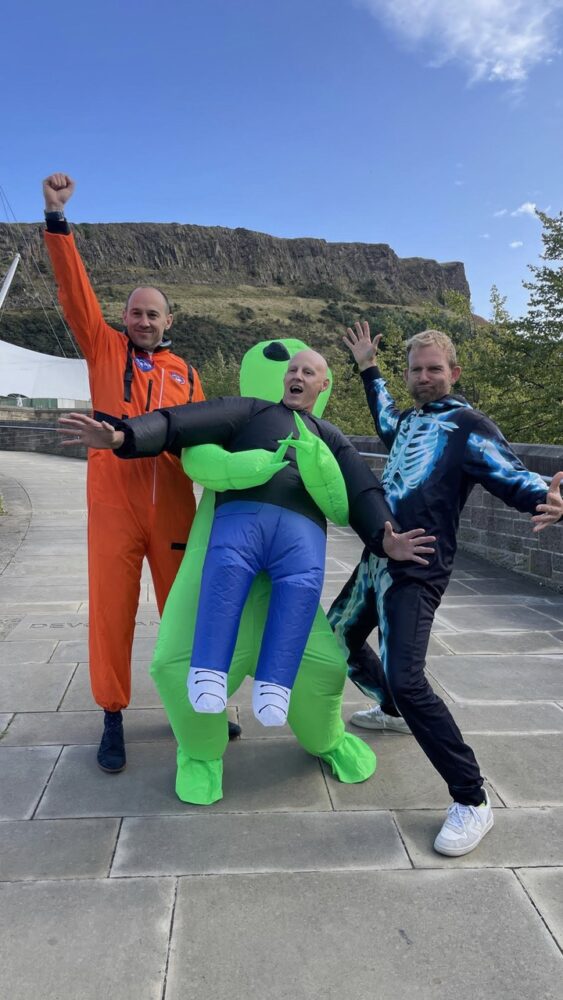Fifteen years ago, Fraser Smeaton’s journey into the fancy dress business began unexpectedly during a weekend in Dublin. A friend’s spandex morphsuit became the centre of attention, drawing laughter and questions from everyone they encountered. Spotting a business opportunity, Fraser, his brother Ali, and friend Gregor Lawson launched what would eventually become Morph Costumes, starting with a small investment and a basic website. The response was immediate; their first 200 suits sold out within days, sparking a rapid expansion that quickly turned their side project into a thriving business.
From securing a major US distribution deal to building a global customer base, Fraser reflects on the company’s rapid growth as well as the obstacles along the way. As consumer trends shifted, Morph Costumes evolved beyond its original morph suits, expanding to over 1,000 unique designs and navigating challenges on platforms like Amazon.

Today, Morph Costumes operates in more than ten markets, employs over 50 people, and reports an annual turnover of £42 million. In this interview, Fraser Smeaton shares how the brand stays ahead of costume trends, adapts to market shifts, and remains a leader in the global fancy dress industry.
How did you come to run a fancy dress company?
Fifteen years ago I was on a weekend away in Dublin with some friends and one of them turned up in this spandex all in one morphsuit. He stole the limelight all night, with groups of people taking his photo and asking where he’d bought the suit. Three of us – myself, my brother Ali and our friend Gregor Lawson – decided there was legs in this as a side hustle so we each put in £1000 and bought 200 costumes to sell via a basic website, promoted with ads on Facebook which, in those early days, was very affordable. They sold out in a matter of days. So we pooled our life savings and bought 2000 more. Which also sold out.
Where did it go from there?
We ran the company for the first year as a Side hustle but when we secured a distribution agreement with a huge US retailer, we decided to take the plunge and go all in on the side hustle. Three years later we were turning over more than £11m in revenue.
Has it all been plain sailing from there?
Sadly, no! After those years of rapid expansion, when we surpassed that double digit million turnover number, the craze for Morphsuits suddenly started to wear off – somewhat inevitably. Between 2012 and 2015 there were some trying times as we worked out how to pivot the business and exploit the untapped market that the Morphsuits phenomenon had proved existed.
Starting in 2015 we began to expand our range significantly and now the original Morphsuits make up only a small percentage of the 1000+ styles we offer.


Any other key challenges you’ve had to overcome?
At the outset of the pandemic we saw a huge fall in sales when people realised there wouldn’t be any parties for a while. Luckily, they did pick up again when it became clear we were going to be in lockdown for some time and people wanted an excuse to dress up, be silly and have some fun. Visual fun like fancy dress worked over the dreaded Zoom calls too, so that worked in our favour.
Previous to that, during our tough times between 2021 and 2015, the change in the Facebook model, when you could no longer talk to your fans at scale for free, required a big shift in strategy. We had built up 1.3m followers but after the changes we couldn’t engage with them at scale without paying thousands of pounds.
Finally, getting to grips with the various stages of the process on Amazon has also been a huge challenge. To get to the level we’re at now has been the result of much focus, trial and error over a decade. Now the years of experience of how to run a very complex business at scale on Amazon, distilled in processes, are one of the key things that protect our business from competition.
Where are you at now?
Today we employ more than 50 people and our latest accounts showed turnover of £42m. We operate in more than 10 markets, including the UK and US & Canada, Australia, Mexico and much of Western Europe.
However, we’re not getting complacent. We know that in order to hold our position as the most successful UK fancy dress retailer we must continue to create the best costumes, quickly, and efficiently get them into the customers hands.. We use data to develop winning costumes and then aim to be the world leader at distributing them directly to consumers around the world through the Amazon marketplace.
Is Halloween dressing up big around the world?
It’s obviously huge in the US (where co-founder Gregor is currently Chairman of the Halloween and Costume Association) and in more recent years the UK, but more and more countries do dress up as Halloween grows around the world.
Halloween is easily our busiest time of year, but such is the public’s love of dressing up that there is high demand for Christmas outfits and themed party wear, while we also cater to World Book Day in the UK, Lent’s Carnival in Western Europe and the younger generations’ love for dressing up as things like Superheroes.

How do you stay on top of different trends and quirks?
A good thing about the costume industry is that the core themes of witches, skeletons and Zombies stay in consistent demand year after year. If you have great design in those categories it will be a good seller each year.
However there are always new themes and new executions that can be added to our range. We look very closely at search & social media data to get an early steer on what is trending. Our design teams can then jump on that and make sure we are ready for when the trend hits the mainstream.
What’s your main route to market?
In short, Amazon. For a D2C business with 1000s of products like ours, Amazon provides an incredible reach through its multi-market network and we’ve built a global network as a result of following them into almost every market. Getting that to work in our favour is no mean feat, as I’ve mentioned, but we are making great strides now.
We sell the majority of our products through Amazon because, quite simply, that’s where consumers go to look for competitively priced fancy dress costumes. The infinite digital shelf gives consumers choice and the free next day delivery promise means they can order when they are ready. We will always assess the data for each market to ensure they have a culture of costumes before launching there, but if a market’s culture is suitable for Amazon to have a presence it follows that there’s usually a demand for fancy dress at some point in the year – assuming Amazon has got to scale in that country. Our due diligence means we’ve never had to backtrack in any market – we’ll have thoroughly researched the data before we take any steps to launch.
Where do you advertise your products?
Almost all our advertising spend is on Amazon, with pay per click advertising capturing the demand on the platform. However we do have plans to move more spend into brand building advertising in the near future, as our product range continues to expand and we are in a position to serve the majority of what the consumer is looking for.
Finally, can you tell us one surprising thing about fancy dress costumes?
A lot of people don’t realise that the reason fancy dress costumes have things like raw seams and ‘untidy’ finishes is all due to the tax code they fall under. It may sound ridiculous but if they were too neat and polished they would be classified as ‘apparel’ and be treated the same as regular clothes, which fall into a far higher tax band and would make the costumes much more expensive for consumers.
That said, regulation is very tight today around safety – particularly in terms of everything being fire safe – which is something we obviously welcome.













